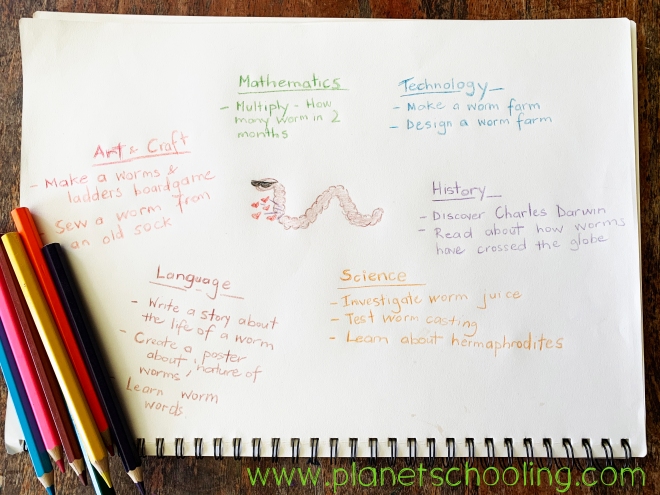The squiggly worm is loved by some and unfortunately feared by most! Yet the worm is one of our best allies. Who would be crazy enough to study worms for forty years, well Charles Darwin of course.
Teaching children to care for worms not only helps the planet but helps us too! Worms create free fertiliser for organic gardens, making your veggies taste better.
Worms have played a more important part in history of the world than humans would at first suppose. Charles Darwin
Cool facts about worms
- The earthworm has 5 hearts! Their hearts aren’t multi-chambered heart like mammals or reptiles, they are a series of single-chambered aortic arches and they have five of them.
- Worms have no head, eyes or teeth. So they don’t bite!
- The earthworm “breathes” through its skin.
- Worms are so strong that they are capable of digging as deep as five meters down and can move a stone fifty times its own weight.
- Worms are hermaphrodites, which means they have both male and female organs of procreation, and must perform a reciprocal act of copulation to fertilise and be fertilised.
- Worms throw their bodily excrements, known as castings or worm humus behind them. This is free fertilizer for nature.

Why make a worm farm
Charles Darwin states that all the fertile areas of this planet have at least once passed through the bodies of earthworms. His book “The Formation of Vegetable Mould” summarizes his studies on earthworms.
Darwin states that the worm is the plough, the chemist, the fertilizer, the cultivator and distributor of nature’s plant food. In any case, the worm surpasses any instrument invented by man to plough, cultivate or fertilize the soil.
Feed nature and she feeds you.

So it makes total permaculture sense to introduce the element of a worm farm into your home garden, and better still it’s a homeschooling project that benefits the planet and your children.
What worms to use for your worm farm
There are several types of worms. The three main categories are:
Epigeic – worms that live close to the soil surface and feed on plant litter. These are the worms we usually use for a worm farm, as they love to munch things for hours on end. Californian red worms are easy to find or ask a friend to gift you some. My first worm farm was created with worm eggs that my daughter and I found in some compost.
Anecic – worms that feed on plant litter, soil and form vertical burrows. These are the worms we usually call earthworms. They prefer to live in nature and are not fond of worm farms, as they like to dig deep. These are the worms that like to throw their castings above the surface of the soil, forming small mounds.
Endogeic – worms that live deep in mineral soil horizons and feed on soil. Hard to find but you may find these worms when excavating a site.
Worm projects
If you are tight for cash, this model of worm farm works fine. It’s really cheap and has been tried and tested. It is also possible to make a worm farm straight on the ground but a little difficult to conatin them. Watch the video here to see the system we use in a home garden.
The power of change
This is a moment for change. The Covid-19 virus has reminded us that we too, need to be in sync with Mother Nature.
It is not the strongest of the species that survives, nor the most intelligent, but the most responsive to change. Charles Darwin
Educating your child/ren to work with nature rather than against nature is a precious gift for the future well being of your child/ren. Good Luck, and send in any questions about worms here! Also sign up for our newsletter. 


Interesting information about worms. Learn something new everyday :).
LikeLiked by 1 person
They are always surprising me too 🙂
LikeLiked by 1 person